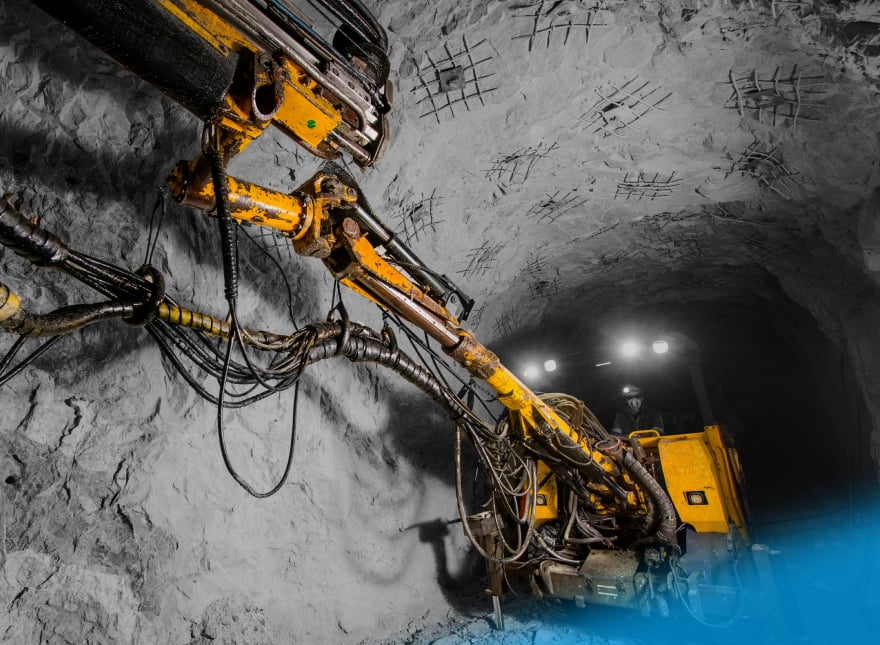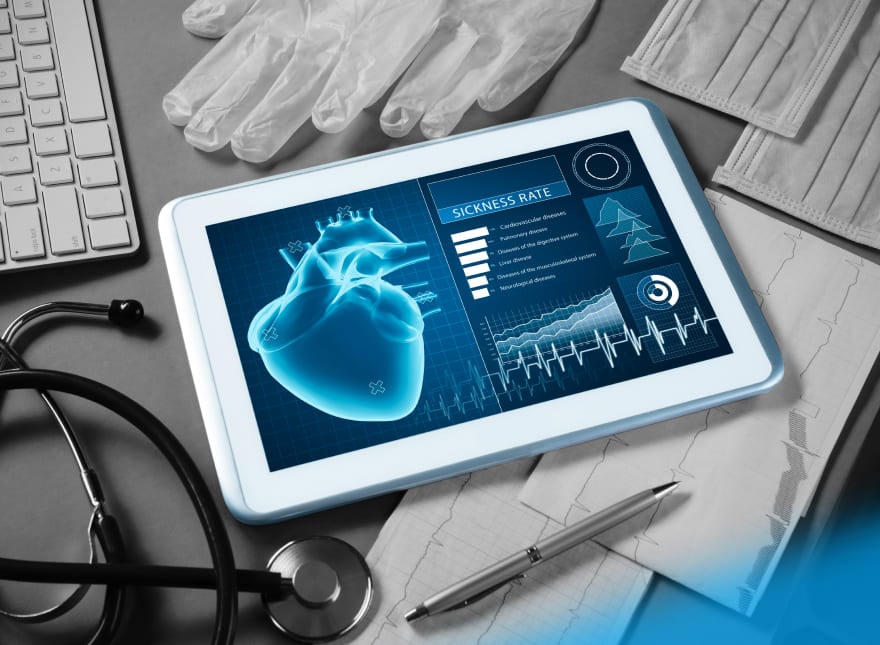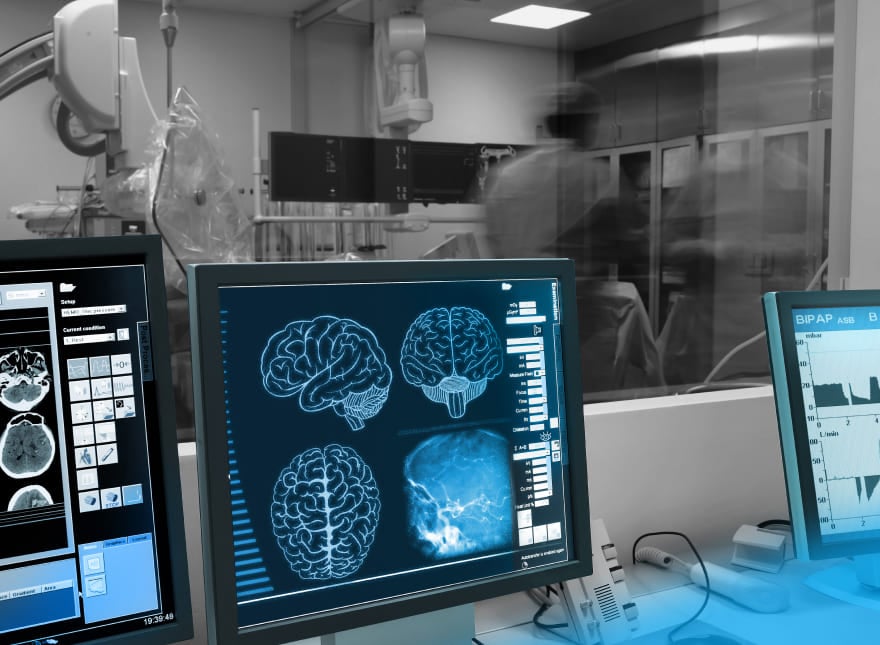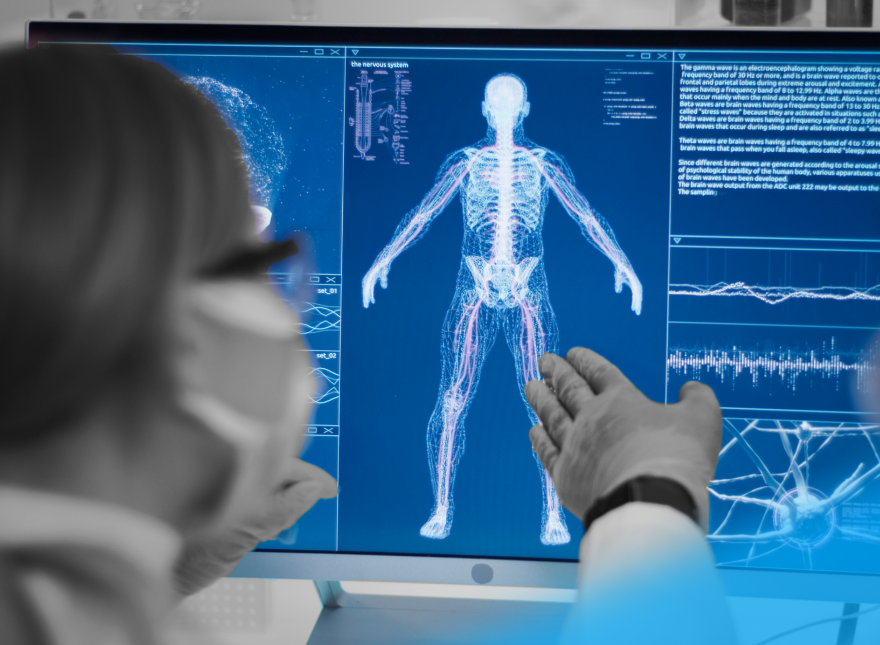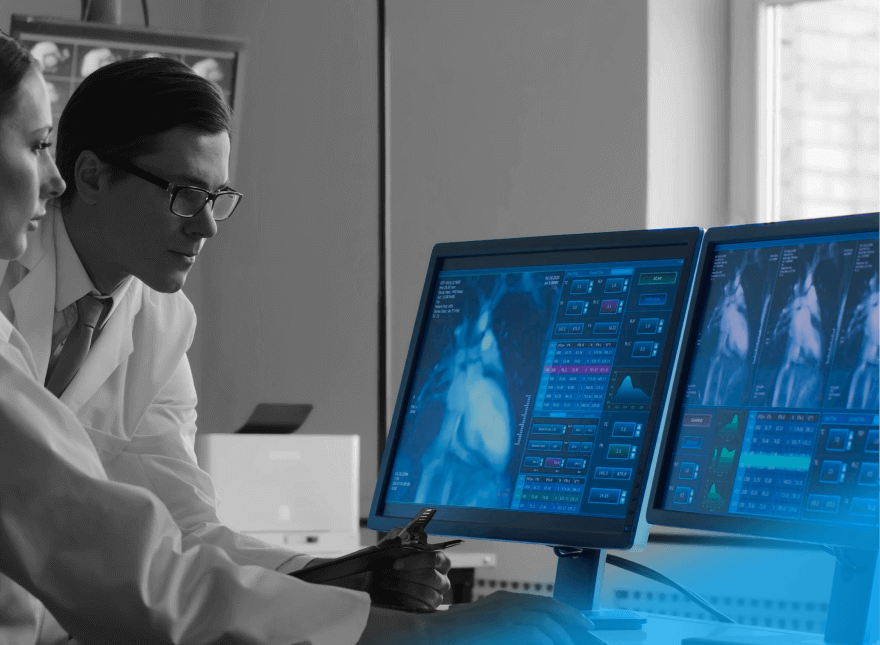Check out our latest blog article: From component to enterprise – modular robotics done right.
AR & VR In Healthcare: 4 Use Cases with Real-Life Examples
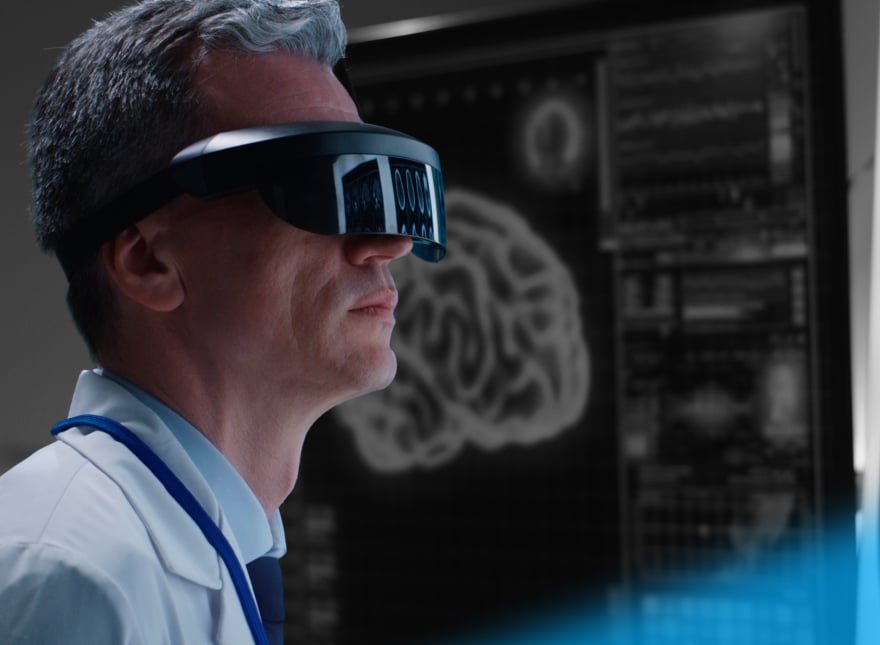
People don’t generally like medical procedures. Many even suffer from medical phobias. Did you know that two in three children and one in four adults have a strong fear of needles? A simple blood test could become a nightmare for them if a nurse were to miss the vein on the first try. This happens quite often—in 40% of all blood tests. But it doesn’t have to be like this.
With the right digital solutions for healthcare, medics can reduce patients’ fears. We’re talking about virtual reality (VR) and augmented reality (AR). When nurses use AR and VR solutions for blood tests, their accuracy rises to 90%. If patients knew this beforehand, they might visit clinics that use these accuracy-enabling technologies.
This is how virtual and augmented reality in healthcare take medical services to the next level. And there are so many areas in healthcare where these two technologies can bring significant value. That’s why many startups are riding this wave in order to deliver more and more sophisticated solutions.
In this article, we’ll look into four use cases of VR and AR in healthcare and explore how both clinics and patients benefit from these technologies.
AR and VR in Healthcare Explained
Before diving into how AR and VR are used in healthcare, we’ll see how they work. AR and VR bring the virtual and real worlds together, enhancing the real one with digital objects. However, they have significant differences and are applied depending on the use case scenario.
VR offers complete immersion in a virtual environment. Users need special equipment like helmets, 3D goggles, headsets, and gloves to experience it. They can even move around and interact with it.
VR in healthcare is used to treat nervous system disorders and relieve anxiety through awareness.
For example, VR can show a patient who needs brain surgery what they are about to undergo by taking a virtual trip inside their brain. VR tools create a 3D model of the brain based on MRIs, CT scans, and angiograms. Using a VR headset and a touch screen, the patient can perceive that model from all angles. This enables them to learn more about their disease and the surgical process, increasing awareness and reassuring them that they will be okay.
AR is not about complete immersion. It only enhances the real-world environment by superimposing digital objects onto it. Users point a camera-equipped device like a smartphone or a tablet at the area of interest to immediately see digital elements on top of that area.
AR in healthcare is especially useful for making medical procedures more accurate and improving diagnostics.
Let’s turn back to the example of vein detection. AR systems use a combination of laser-based scanners and processing units. The system scans the skin, sees the underlying vasculature, and projects it onto its surface. This shows medics exactly where veins are located and increases the accuracy of needle insertion.
The application areas of virtual and augmented reality in healthcare are currently expanding as they are able to solve increasingly complex problems. Both doctors and patients have already evaluated their benefits. Analysts predict the AR and VR market in healthcare will grow rapidly in response.
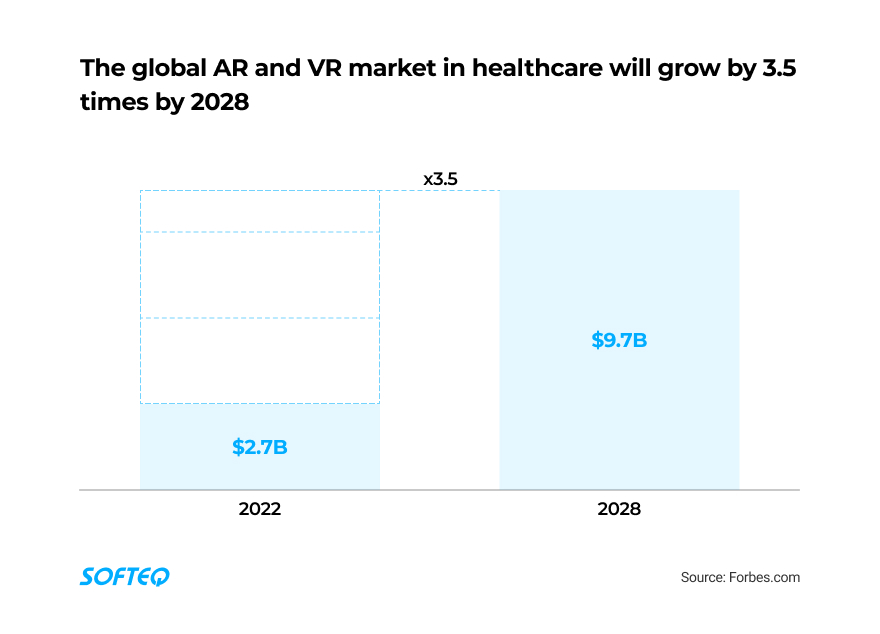
Now, let’s zoom in on how AR and VR are used in healthcare and discover real-life examples.
Use Case 1. AR for 3D Body Mapping
Performing surgery is always risky. Often, problems arise from not having a clear view of a patient’s internal organs. MRIs and X-rays help doctors navigate, but the picture only becomes clear during the surgery itself. In some cases, this can lead to surgical errors that slow the recovery process and even cost patients their lives. As for healthcare facilities, they have to deal with legal disputes, fines, and loss of reputation.
To avoid that scenario, tech startups design AR tools that create virtual 3D patients with body maps. First, the solution studies MRI scans. Then, it processes the information obtained from the scans and presents it in 3D body layers.
When a doctor points an AR-equipped device to the patient, they see beyond the skin’s surface.
They can examine even the smallest 3D body section together with organs, veins, arteries, and bones. They can also spot tumors, inflamed spots, and other places that need treatment. These tools enable accurate surgery and help doctors make better decisions.
Real-Life Example: Reconstructing 3D Body Sections
Iowa Spencer Hospital wanted to make medical procedures safer and achieve greater accuracy in diagnostics and surgery. To achieve this, they tried an AR solution in their day-to-day treatment activities that was designed by a US startup. The AR tool is based on simultaneous localization and mapping (SLAM) technology. To see inner organs, doctors just need to direct the smartphone toward a specific area of the patient’s body. They can virtually map the body, including its organs, veins, and any tumors.
The resulting accurate body scans enable medical manipulations. These have helped increase biopsy success by 50% and the accuracy of aneurysm surgeries by 30%.
Benefits:
- Achieving safer medical manipulations with more precise body maps
- Having a better view of a patient’s internal organs with 3D anatomy
- Improving complicated medical procedures to find the best treatment option
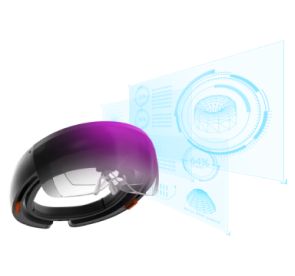
Use Case 2. AR for Maintenance in Medical Labs
Modern medical laboratories are equipped with advanced microscopes, cell counters, and other high-precision equipment. But, like all hi-tech equipment, lab tools are prone to breakdowns. This equipment is so complicated and tends to be so hard to fix that labs have to call out third-party experts to mend it. This may take days or even weeks, costing a fortune.
Unplanned lab equipment downtime also causes many problems for hospitals. Without test results, doctors can’t diagnose patients and arrange treatment plans. Patients have to wait, losing valuable time. As a result, hospitals record lower patient satisfaction scores and loss of trust.
AR can help in-house lab technicians conduct maintenance and repair procedures quickly and autonomously. Third-party engineers won’t need to be physically present as the technology enables remote support. Using AR helmets and glasses, engineers conduct live video streams with remote experts. Experts guide an engineer through the repair process, providing instructions that make it smooth and quick.
The technology can also help technicians fix the equipment on their own using AR instructions. A technician would point an AR-based device at a broken piece of equipment so that it immediately presents 3D visualizations of its inner structure. Then, it superimposes simple step-by-step maintenance and repair manuals. These help technicians fix equipment even without remote assistance.
Real-Life Example: Fixing Lab Equipment
LabFlorida uses AR remote assistance to fix and maintain their medical test equipment. Before, they had to rely on experts who came onsite to resolve problems. This took time and money, and still resulted in numerous human errors. Now, their engineers can connect with remote experts via AR glasses and get the technical guidance they need.
As a result, their on-site technicians can now fix almost any failure on their own, all in a matter of hours—not days. Moreover, the maintenance process has become easier and more productive. In 2022, the company saved approximately $500K on maintenance activities.
Benefits:
- Reducing the duration and cost of maintenance
- Bridging the skill gap between on-site engineers and remote technicians (who are usually more senior)
Use Case 3. VR for Mental Health Treatment
Mental Health America rings the alarm: one-fifth of the adult American population suffers from some type of mental illness. 60% receive no treatment or medication because they ignore their symptoms. Some deliberately postpone visiting their doctor because they fear the unknown. What’s more, many are afraid of taking pills due to the possibility of addiction without positive effects.
VR has brought dramatic changes here. First and foremost, it facilitates drug-free treatment. This has been proven to be effective, comfortable, and convenient as patients may not even need to leave their homes.
The technology enables meditation and breathing exercises in immersive environments. It also gives people the opportunity to confront their fears.
For example, someone who has a phobia of spiders or big waves can process their fears in a virtual environment. They might ride those big waves or play with spiders. This adds an element of fun to a fearful situation while teaching stress-management techniques and coping mechanisms.
There are also games people can use for distraction. These work well for anxiety management and relief.
Overall, VR for mental health treatment offers a type of therapy that can ease anxiety, phobias, and symptoms of depression. For instance, patients learn how to manage their symptoms in a simulation so that they can transfer that knowledge into the real world.
Real-Life Example: Treating Cognitive and Behavioral Health Conditions
XRHealth developed a virtual clinic that treats mental health disorders using VR therapy. The solution consists of VR headsets, a mobile application, and a data analytics platform. The clinic is aimed to de-stress the nervous system and treat psychosis and depression. What’s important is that patients get treatment from the comfort of their homes with guidance from a licensed therapist.
One of XRHealth’s clients, a US healthcare provider, uses the solution to treat patients with phobias. For example, if a patient has a fear of large crowds, the VR tool creates a safe simulation of being surrounded by lots of people. The patient can move on to more intense situations when they show progress.
Last year, the company conducted research based on 470 patients. They found that 424 patients managed to fully overcome their fear and anxiety. Almost half of them previously had severe symptoms.
Benefits:
- Increasing the number of complete recoveries from mental disorders thanks to more targeted, personalized treatment
- Achieving more effective drug-free therapy conducted at home
Use Case 4. VR for Pain Management
Painkillers don’t just kill pain. The statistics are disappointing: every day, 40 people in the US die from prescription opioid overdoses. That’s more deaths than from heroin and cocaine combined.
People often misuse painkillers because they bring rapid relief and contain highly addictive substances. To have a greater effect, people exceed the prescribed dose and become addicted.
VR serves as a drug-free pain management alternative to traditional anesthetic methods. The technology could reduce the use of harmful painkillers and save lives. To soothe pain, VR apps offer various interactive games that provide cognitive distraction. In other words, using VR, patients are immersed in an entertaining virtual environment—perhaps an interactive gamified experience or realistic, relaxing surroundings. These experiences switch the focus of a patient’s brain. The pain subsides, and patients find relief.
Real-Life Example: Easing Pain
St. Jude Research Hospital wanted to offer their patients a drug-free method of coping with chronic pain. Their goal was to minimize the use of addictive opioids and help patients for whom sedation is contraindicated. To achieve this, they tried EaseVRx, a VR platform that uses goggles and headsets to create an immersive 3D world.
The solution offers various programs, including pain distraction via immersive games and escapes in relaxing environments. The platform also provides patients with educational tools that teach them how to manage their pain. After six months, the hospital admitted that they had managed to reduce pain scores by 50%. They also saved $200K on purchasing pain-relieving drugs every month.
Benefits:
- Reducing the use of highly-addictive opioids in treatment
- Lowering hospital admissions due to the effectiveness of VR treatment
- Providing safe treatment for those who cannot tolerate analgesics
Case Closed
As seen from the examples above, AR and VR applications in healthcare are forging ahead as the technologies become more and more advanced. AR and VR in healthcare are now capable of solving more and more complex tasks. They were mainly used for medical training and diagnostics earlier on, but today, clinics use AR and VR for mental health treatment and chronic pain management. They can also help map the human body and fix medical equipment more quickly.
Are you interested in healthcare AR/VR solutions? Let’s talk. We have a team of AR and VR experts who can help you turn your tech idea into reality.
More articles on the topic
